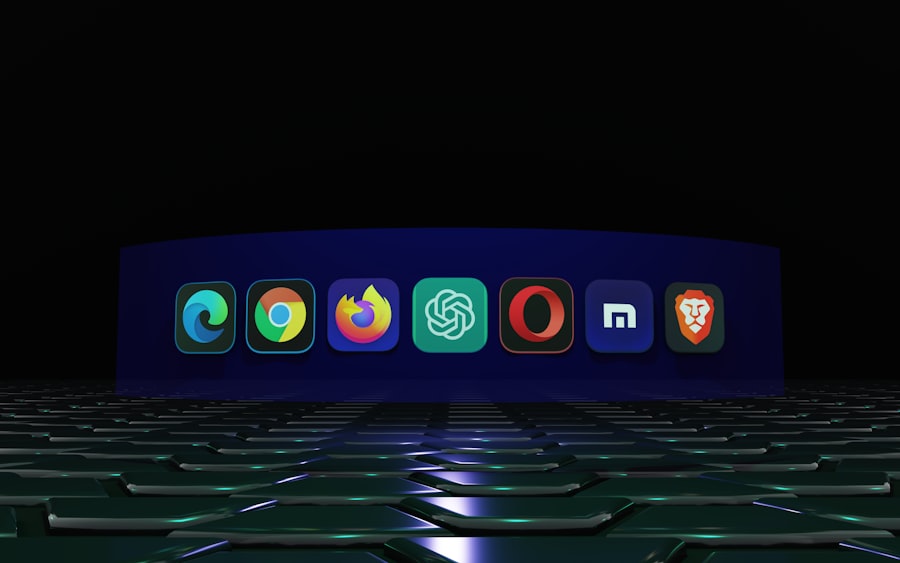Augmented Reality (AR) has emerged as a transformative technology in various sectors, and education is no exception. By overlaying digital information onto the real world, AR apps create immersive learning experiences that can enhance understanding and retention of complex concepts. This technology allows students to interact with 3D models, animations, and simulations in ways that traditional teaching methods cannot achieve.
For instance, a biology student can visualize the intricate structures of a cell in three dimensions, rotating and examining it from different angles, which fosters a deeper comprehension of cellular functions. The integration of AR into educational settings is not merely a trend; it represents a significant shift in pedagogical approaches. As educators seek innovative ways to engage students and cater to diverse learning styles, AR provides a dynamic platform that can accommodate visual, auditory, and kinesthetic learners alike.
The potential for AR to bridge the gap between theoretical knowledge and practical application is immense.
Key Takeaways
- AR apps enhance learning by overlaying digital information onto the real world, making education more interactive and engaging.
- Consider factors such as subject matter, grade level, and technical requirements when choosing the right AR app for educational purposes.
- Integrate AR apps into the classroom curriculum to create immersive learning experiences and enhance student understanding of complex concepts.
- Engage students with interactive AR learning experiences that encourage exploration, problem-solving, and critical thinking.
- Foster collaborative learning by using AR apps to facilitate group projects, virtual field trips, and shared learning experiences.
Choosing the Right AR App for Your Educational Needs
Selecting the appropriate AR app for educational purposes requires careful consideration of several factors. First and foremost, educators must assess the specific learning objectives they aim to achieve. Different AR applications cater to various subjects and grade levels, so it is crucial to align the app’s capabilities with the curriculum requirements.
Another critical aspect to consider is the user interface and accessibility of the AR app. An intuitive design that is easy for both teachers and students to navigate can significantly enhance the learning experience.
Additionally, compatibility with existing devices—such as tablets or smartphones—should be evaluated to ensure that all students have access to the technology. Furthermore, educators should look for apps that offer robust support and resources, including tutorials and lesson plans, which can facilitate smoother integration into classroom activities.
Integrating AR Apps into the Classroom Curriculum

Integrating AR apps into the classroom curriculum involves more than just introducing new technology; it requires a thoughtful approach to ensure that these tools complement existing teaching methods. One effective strategy is to incorporate AR experiences into project-based learning. For instance, students could use an AR app to create a virtual museum exhibit on a historical topic, allowing them to research, design, and present their findings in an engaging format.
This not only enhances their understanding of the subject matter but also develops critical skills such as collaboration, creativity, and communication. Moreover, teachers can leverage AR apps to facilitate differentiated instruction. By providing various levels of complexity within the same app, educators can cater to students with different learning paces and styles.
For example, an AR app that teaches mathematical concepts might offer basic visualizations for struggling learners while providing advanced problem-solving scenarios for those who excel. This adaptability ensures that all students remain engaged and challenged, fostering a more inclusive learning environment.
Engaging Students with Interactive AR Learning Experiences
One of the most compelling advantages of AR in education is its ability to create interactive learning experiences that captivate students’ attention. Traditional methods often struggle to maintain student engagement, particularly in subjects perceived as challenging or dry. However, AR apps can transform mundane lessons into exciting adventures.
For instance, an app that allows students to explore the solar system by virtually traveling between planets can ignite a passion for astronomy that textbooks alone may not inspire. Additionally, interactive AR experiences can promote active learning by encouraging students to participate rather than passively absorb information. For example, an app that simulates chemical reactions can allow students to mix virtual substances and observe the outcomes in real-time.
This hands-on approach not only reinforces theoretical knowledge but also cultivates critical thinking skills as students hypothesize about the results of their experiments. By immersing learners in these interactive environments, educators can foster a sense of agency and ownership over their educational journey.
Collaborative Learning with AR Apps
Collaboration is a cornerstone of effective education, and AR apps can significantly enhance cooperative learning experiences among students. Many AR applications are designed with multi-user capabilities, allowing groups of students to interact with the same virtual content simultaneously. This feature encourages teamwork as students work together to solve problems or complete tasks within the augmented environment.
For instance, a group project using an AR app focused on environmental science could involve students collaboratively analyzing data from virtual ecosystems and proposing solutions to real-world issues. Furthermore, collaborative learning through AR can extend beyond the classroom walls. With cloud-based AR applications, students can share their projects with peers or even collaborate with other classrooms around the world.
This global perspective not only enriches their learning experience but also fosters cultural awareness and empathy as they engage with diverse viewpoints. By utilizing AR technology for collaborative projects, educators can prepare students for the interconnected world they will navigate in their future careers.
Assessing Student Progress and Understanding with AR Technology

Assessing student progress in an AR-enhanced classroom presents unique opportunities for educators to gain insights into individual learning trajectories. Many AR apps come equipped with built-in assessment tools that allow teachers to track student interactions and performance in real-time. For example, an app that teaches geometry might provide instant feedback on a student’s ability to identify shapes or solve spatial problems, enabling educators to identify areas where additional support may be needed.
Moreover, AR technology can facilitate formative assessments that go beyond traditional testing methods. Instead of relying solely on quizzes or exams, teachers can observe how students engage with AR content during lessons. This observational data can provide valuable context regarding student understanding and engagement levels.
Additionally, incorporating self-assessment features within AR apps encourages students to reflect on their learning processes and outcomes, promoting metacognitive skills that are essential for lifelong learning.
Overcoming Challenges and Limitations of AR in Education
Despite its numerous advantages, the integration of AR technology in education is not without challenges. One significant barrier is the accessibility of devices required to utilize AR apps effectively. While many students have access to smartphones or tablets, disparities in technology availability can create inequities in learning opportunities.
Schools must consider investing in adequate resources or exploring partnerships with organizations that provide technology access to underserved communities. Another challenge lies in the need for professional development for educators. Many teachers may feel apprehensive about incorporating new technologies into their teaching practices due to a lack of familiarity or training.
Providing comprehensive training programs that equip educators with the skills necessary to effectively use AR apps is crucial for successful implementation. Additionally, ongoing support and resources should be made available to help teachers navigate any technical difficulties they may encounter while using these tools in their classrooms.
Future Trends and Developments in AR Education
The future of AR in education holds exciting possibilities as technology continues to evolve at a rapid pace. One emerging trend is the development of more sophisticated AR applications that leverage artificial intelligence (AI) to personalize learning experiences further. These AI-driven apps could analyze individual student performance data and adapt content dynamically based on their unique needs and preferences, creating truly customized educational journeys.
Moreover, advancements in hardware technology are likely to enhance the accessibility and usability of AR applications in classrooms. As devices become more affordable and user-friendly, schools will be better positioned to integrate AR into their curricula seamlessly. Additionally, the rise of virtual reality (VR) technologies may lead to hybrid learning environments where students can transition between augmented and virtual experiences, further enriching their educational experiences.
As educators continue to explore innovative ways to engage students through technology, the potential for AR in education remains vast. By embracing these advancements and addressing existing challenges, schools can harness the power of augmented reality to create dynamic learning environments that inspire curiosity and foster a love for lifelong learning among students.
In the realm of educational technology, augmented reality (AR) apps are revolutionizing the way students engage with learning materials. These apps provide immersive experiences that can make complex subjects more accessible and engaging. For those interested in exploring the potential of technology in education further, the article “Unlock Your Potential with the Samsung Galaxy Book2 Pro” offers insights into how modern devices can enhance learning experiences. The Samsung Galaxy Book2 Pro, with its advanced features, can serve as an excellent platform for running AR educational apps, thereby unlocking new possibilities for both educators and students.
FAQs
What are AR apps?
AR apps, or augmented reality apps, are applications that use technology to overlay digital information or virtual objects onto the real world, typically viewed through a smartphone or tablet camera.
How can AR apps be used for educational purposes?
AR apps can be used for educational purposes by providing interactive and immersive learning experiences. They can bring abstract concepts to life, allow for hands-on exploration, and engage students in a way that traditional methods may not.
What subjects can AR apps be used for in education?
AR apps can be used for a wide range of subjects in education, including science, history, geography, mathematics, language learning, and more. They can be tailored to specific learning objectives and curriculum requirements.
What are some examples of AR apps for educational purposes?
Examples of AR apps for educational purposes include apps that allow students to explore the solar system, dissect virtual animals, visit historical landmarks, practice language skills, and conduct virtual science experiments.
What are the benefits of using AR apps for educational purposes?
The benefits of using AR apps for educational purposes include increased student engagement, improved understanding of complex concepts, opportunities for hands-on learning, and the ability to cater to different learning styles. AR apps can also make learning more fun and memorable for students.

